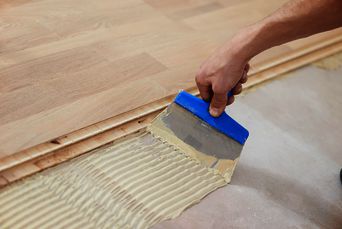Style and comfort beneath your feet
The flooring chosen for a room covers the entire floor area. It thus has a decisive impact on the appearance of the room. And you always feel it under the soles of your feet. If you want to make sure that the flooring still looks good after many years and increases your living comfort, it should be installed with a health and environmentally friendly flooring adhesive. But what is the best way to design the underfoot area? We tell you what is important.
1. Appearance and functionality are important when choosing a floor covering
Carpet, parquet or luxury vinyl flooring? Whether you just refurnish your home or do a complete makeover: you will be spoilt for choice. The important thing is that the floor meets the requirements of the room. It’s the structure underneath that has a decisive impact on the floor’s durability and comfort. Parquet flooring, for instance, is also suitable for use in kitchens and bathrooms. You just need to choose the right type of wood and full-surface bonding. Thanks to technical progress, modern floor coverings combine style and practical functionality. Simply seek professional advice so you know whether the properties of the flooring match the room – and then follow your taste.
2. Bonded installation
If the floor coverings are fully glued to the substrate, they will look good for years to come. Thanks to the powerful bond, they will firmly stay in place. However, when choosing loose lay or floating installation, the floor coverings will always remain in motion. This leads to faster wear and causes disturbing room noise. Bonding instead of loose lay also protects the flooring against climatic influences. Under the influence of heat and humidity, flooring normally tends to expand, resulting in buckling and tenting seams. On the other hand, the flooring may shrink at low temperatures and dry indoor air, which may lead to the formation of joints. These problems can be avoided by full-surface bonding. By bonding, the heat from underfloor heating systems is transferred into the room much more quickly and efficiently, because there is no separating air layer between floor covering and substrate – a benefit for our environment and your household budget. In terms of design, there are practically no limits. Different flooring materials can be mixed and installed through several rooms in a row, on the same height and without disturbing rails.
3. The importance of quality seals
A glance at the packaging provides assurance that the selected installation products protect health and environment. When bearing the EMICODE® seal, adhesives, primers, fillers and many other products have been certified to comply with the world’s strictest emission limits. Before they are granted the label, the products undergo tests in a test chamber carried out by independent laboratories. Regular spot checks by neutral experts and testing institutes monitor long-term compliance with the limit values. This is an important advantage of EMICODE® over other certificates for health and environmental compatibility.

©Dmitry Kalinovsky/123rf.com
Share article on Social Media:
